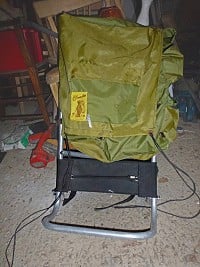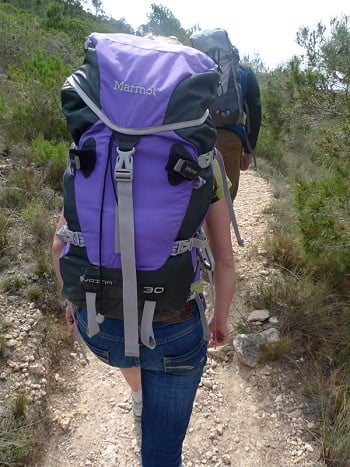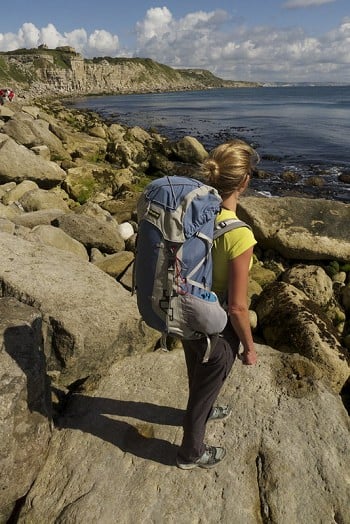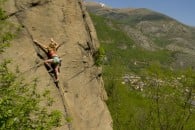
Three general purpose 30-40 litre rucksacks gear-tested: the 30 litre Marmot Myrina, 32 litre Deuter ATC Trail and 40 litre Lightwave Fastpack 40. All are priced between £90 - £100.

I'm British, so instead of enjoying the American dream, I'm going to complain that nowadays I think some rucksacks have over-evolved. Outdoor gear in general has completely revolutionised over recent decades - then some of it seemed to keep going and get over-engineered and over-featured. Now the trend seems to be bucking, though. A puritanical counter-revolution is resulting in a generation of new watchwords: everyone, from punters to pros, seem to be wearing 'stripped back' kit designed for moving 'fast and light' and/or for adventures that are 'done-in-a-day'.
What I like about the Marmot Myrina (below), is that it doesn't look very exciting and, well, it isn't. It's just a rucksack. For me, it has all the features I need in a 30 litre pack, and none of the extras I don't want to carry.
Features
- Removable lid with zip pocket and key clip
- Storm collar with top compression strap
- Women's specific shoulder harness
- Hydration sleeve with hanging zip pocket
- Moulded back panel
- Stowable padded waist belt with gear loops
- Removable frame sheet
- Dual ice axe loops
- Lid and front lash points
- Integrated vertical rope carry system
- Colour: Ultra Violet/Dark Coal
- Weight: Small 1134 g / Medium 1191 g
- Volume: Small 28 litres / Medium 30 litres
- Main Materials: 210d Nail Head Nylon, 420d High Density Nylon
- Reinforcement Material: 840d Ballistic Nylon
Marmot Myrina 30
RRP £90
www.marmot.com
I had a 30 litre women-specific Myrina on test, which is the 'medium' women's back length; a 28 litre 'short' back length version is also available. For a men's version, you can check out the similar Centaur, which comes in 30 and 38 litre versions (UKC Review: Marmot Centaur).
Pockets
There's one main compartment, with only one way in: it's a top-loader. You can easily see what and how you're packing things in there because it has a big wide mouth (the shape narrows on its way down your spine) and it's a bright orange inside.
The lid has a wide zip running around half of its circumference. Great for fitting in bigger items and accessing things at the back, but I'm a dab hand at dropping small, valuable items, especially when there's the added possibility they may fall off a cliff into the sea. I pack things like money and keys in a little hanging pocket, about 4x6 ins in size, which dangles on the inside. The lid strips off altogether if you don't need it. This of course leaves the entrance and top of your pack more exposed to the elements but is useful for stripping back the rucksack even more - say if you've carried all your gear to a hut or other base and are then going to be making day trips with less gear.

What else? Two compression straps with clip fasteners double as accessible places to attach baguettes (if you're Rob Greenwood), poles, or other tall thin objects that won't fit inside. A removable plastic sheet offers a bit of extra stiffness, shape and protection for your back when carrying a bunch of misshaped objects. This sheet is very lightweight, and I can't see why you'd want to remove it, unless to sit on it, perhaps. Pretty much standard on all rucksacks these days, the Myrina has a 'hydration system' (i.e. a pocket for a water bladder and a hole and clips for a tube).
I liked the ice tool attachment system: essentially there are the typical twin webbing loops at the bottom, but the top fasteners are chunky Velcro with tabs, rather than that fiddly, stretchy shock cord that I find stings my hands if I accidentally ping the toggle fumbling in cold weather. This pack hasn't had its first winter yet, but I've found these Velcro tabs easy to use with cold hands and they seem very secure and tidy.
The waist belt has gear loops so you can dangle extras if you can't fit them in your pack, or generally want to show off your hardware. The belt itself is designed to tuck away, which I've found useful for air travelling: allowing you to easily slip the pack overhead on a plane before you get stampeded out of the way by the queue behind.
The internal seams are reinforced with webbing, and the pack generally feels hardwearing and well made. It's not the kind of pack you'd be happy to drag around at the foot of a crag though, and I'll be careful with sharp crampons near it, as the thinner main body fabric is a lightweight (but strong) 210 Dernier.
Comfort and Fit
As for comfort, there's enough, but no more. The back panel and waist belt are lightly moulded with EVA foam. A benefit of the light padding is that it doesn't soak up much water. The Myrina's shoulder straps are attached in the same way as on the Centaur. As Toby commented in his review, these strips of hardy but thin silicone-like fabric reduce bulk and allow your shoulders to move more freely, making the rucksack ideal for activities where you use your hands and arms more. While the chest straps work well in the usual way, helping to distribute weight across the front of the chest and allowing more arm movement, I have a small complaint that I found them difficult to slide up and down to adjust their height.
Summary/Best for?
To me, this is a neat, no frills, lightweight, general purpose done-in-a-day pack, which I will mainly use for summer, as I expect I'll prefer the Fastpack 40's features and weather proof exterior for winter. It's a versatile size - I can carry plenty to sustain two on a day walk; a rack and rope; it'd fit kit for day winter trips and is still lightweight and cinches small if you're not carrying much. Small concerns: the lightweight fabric means I won't be dragging it about at the crag, and it's tricky to adjust the height of the chest strap.
Lightwave Fastpack 40
RRP £99
www.lightwave.uk.com
Another stripped back pack, this one is a simple rectangle in design. Free from, well, anything not strictly practical, it really stands out for its no-nonsense style.
Features
- Weight: 1100g
- Back length: Unisex 1 (45cm)
- Load: 9-12 kg (15 kg max)
- Colour: Heatwave Yellow, Canyon Blue, Horizon Blue, Stealth Grey
- Single-piece back panel moulded from EVA foam
- Lightweight hipbelt with dual adjustment
- Watertight external lid pocket
- 2 x ice-axe / walking pole holders
- Stash side pockets - stretch mesh
- Side compression straps
- Ski holders
- Watertight construction
- Fabrics: 420d Dynatech fabric on back panel and structural areas
- 300d micro-ripstop polyester on main front areas
- 40d ripstop nylon internal fabrics
Pockets
There's a lid pocket that, unusually for a rucksack, has a water resistant zip (more on the pack's superb water resistance in a bit), and I sometimes use the stretchy shock cord on the outside of it to stow an emergency layer within easy reach. The lid doesn't come off or extend. On the pack's sides, stretchy pouches are handy for snacks but it seems a shame these aren't long enough to safely house my water bottle.
A downside I found to the bag's lanky shape is that it is trickier to (a) pack this top loading bag and (b) find things inside, particularly because the 'neck' (AKA 'storm collar') of the bag is also very long - 8 inches/20cm.

Most seams are welded or taped, so this pack is very water resistant and ideal for wet climates and winter trips. The thicker seams at the back aren't welded or taped (the ones attaching the back panel and straps), so some seepage can occur here, but I've found it generally doesn't, as they are largely protected by pressing against your back and under your jacket's hood. The 300D fabric on the front seems hard wearing.
Standard loops on the front can secure tools out of the way, and I liked the neat, dedicated ski holding tabs on the side, which hold skis securely - when tested indoors at least! - I look forward to testing it properly this winter. The ski holding tabs combine with straps running up the sides of the pack, which zigzag through loops, and fasten with a clip buckle at the top. They can also be used as compression straps or to clip on something that won't fit inside (see pic right).
Comfort and Fit
The rucksack is a comfortable shape. Removable twin rods in the back panel fit neatly against my back, running down behind a narrow, moulded, well padded and mesh covered back panel. It fits close against the back but allows plenty of freedom of movement thanks to its slim design, making it ideal for scrambling and that kind of thing; this pack will be my first choice for ski mountaineering this winter, too.
The shoulder straps curve well to my shape, and the rucksack in general fits me very well. Surprisingly well, in fact. It's unusual for a unisex rucksack to fit small women neatly. There aren't oodles of straps dangling like spaghetti everywhere and it doesn't dwarf me. Lightwave's size chart calls its size 'Unisex 1' - it's designed to fit people from 5'4" to 5'9". Bigger chaps may have to upsize to the Fastpack 50, which is designed to fit people of larger proportions.
The harness is minimal but comfortable. The waist belt is wide, but has a gap in the middle, giving extra support without being overly bulky. The tabs pulls inwards rather than outwards as on most rucksacks I've tried, which I actually find easier to adjust. The chest straps are easy to slide up and down to adjust where they sit.
Summary/Best for?
Another stripped back pack. This one has excellent water resistance and a neat ski attachment system, as well as the usual ice tool holders. It's likely to become a favourite for winter trips and will probably come ski mountaineering this winter. A concern: I found it tricky to pack and find things inside due to the skinny shape and long neck.
Deuter ACT Trail 32
RRP £90
www.deutergb.co.uk
This rucksack has the most pockets and the comfiest harness/back system, making it the heaviest pack on test, and more suited to comfort-and-conveniencers than fast-and-lighters.
Features
- Weight: 1350g
- Capacity: 32 litres
- Main compartment: Lid/drawcord
- Back system: Aircontact (channelled)
- Contoured padded shoulder straps, waist belt.
- Various pockets
- Toggle straps double as compression straps
- Rain cover
- Colours: Granite/black
Pockets
The ACT Trail is an organised person's dream - it has plenty of stowing options to experiment with. Another top loader, it also has a U-shaped two-way zip on the front, giving good access to items in the middle and bottom of the pack without unpacking everything.
There's a big mesh pocket on the front, which can secure layers you want to get to quickly, or a helmet, crampons - things of that size. Further stretchy criss-crossing on the front seemed a bit redundant to me but I guess they add to the pack's versatility for not much weight: making this little 32 litre pack able to carry more if necessary. The straps attaching this front pocket double as compression straps, and I found work well as such.
The lid pocket has an inner and outer pocket, so you can store valuables in one and stuff you might want to get at during the day in the other: I did wonder why these were both so small - they don't make full use of the size of the lid, and aren't big enough to stow a regular size guidebook or OS map, for example.

A zipped pocket on one side of the pack is tall enough to secure a flask, or a good stack of M&Ms and cakes, and there's a stretchy open-roofed pocket of the standard variety on the other side, which can hold a water bottle. A little pocket on the hip belt at the front can secure a small camera or snack in easy reach.
Other Features
There aren't many extra features - just extra pockets - on this pack. A rain cover is tucked in a zip pocket at the base, and there are the standard loops and shockcord attachments for tools. The plastic insert in the back panel is non-removable, and the lid doesn't come off either, so you can't strip weight from this pack.
Comfort and Fit
Two mesh covered foam panels run down either side of the spine providing comfort and a ventilation channel. It's the most comfortable 'back system' out of the three tested. This well padded 'Aircontact' back panel is very comfortable; most noticeably at the base of the back when carrying heavier loads. The airflow it offers was noticeable over the summer - I had a less sweaty back than when carrying one of the other packs.
As for the harness - it's very comfortable too, with a curved shape and a bit of padding. As on the Myrina, the waist straps pull inwards rather than outwards to adjust them. The chest straps can slide up and down to adjust them, and they move easily.
Summary/Best for?
Built for those who love comfort and being organised! Loads of pockets and an excellent back system. A downside to consider: the pay off for these features is more weight.













Comments